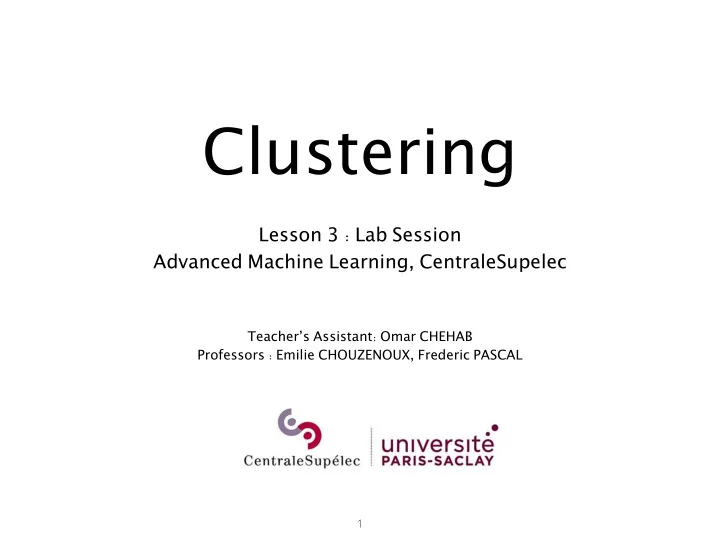

Clustering Lesson 3 : Lab Session Advanced Machine Learning, CentraleSupelec Teacher’s Assistant : Omar CHEHAB Professors : Emilie CHOUZENOUX, Frederic PASCAL 1
General Information • Assignment : alone or in pairs, you will code the algorithms you learnt in ‘scikit- learn formalism’, and apply them to images and text. • Due : the 5 lab assignments for lessons 3-7 are due a week from when they are given, at aml.centralesupelec.2020@gmail.com • Grading : each assignment is worth 4 points — your 4 best labs out of the 5 will be retained and will count for half of your final grade. • Questions : questions or feedback are welcome after class or by email at l-emir-omar.chehab@inria.fr 2
Lesson: recap Robust type n_clusters Objective Algorithm Clusters to K m 2 Points ∑ ∑ x i − c k min δ ik alternatively assign points to clusters, K-Means partitional hardcoded that are δ ik , c k recompute clusters as center-of-points k =1 i =1 near.. cluster sets within-cluster (location and assign.) variance hierarchical Agglomerative given by… sequentially compute distance (e.g. min) (bottom- Single- - between clusters and merge the two nearest init …nearest up: Linkage ‘cuto ff ’ ε clusters, until you end up with one cluster. merge) given by… Identify core points as having at least minPts in their ε -neighborhood. …and … and in ‘cuto ff ’ ε Their connected components on the ε - partitional - outliers, dense DBSCAN neighbor graph make the clusters. noise regions density Non-core points either join an ε -nearby minPts cluster, else are noise. 1. Build complete graph weighted by specific metric that penalizes sparsity* 2. Extract the minimum spanning tree given by… 3. Construct a cluster hierarchy of connected … that hierarchical components by removing heaviest edges ‘cuto ff ’ ε …and are not HDBSCAN (top-down: - 4. Condense the cluster hierarchy based on n_clusters easily split) a min. cluster size before merge (less is density split noise) minPts 5. Extract the clusters with long antecedance (robust to cuto ff ) in the condensed tree : tunes ε for each cluster. *for two ‘close’ points, clamp their distance to that to the farthest Minpts neighbor.
From a modelling standpoint hierarchical ‘family’ partitional ‘cut’ inter-cluster A partitional clustering can sometimes be framed as the ‘cuto ff ’ of a hierarchical clustering, i.e. as the instance of a relaxed problem in which it is embedded. For e.g., DBSCAN ( partitional ) can be understood as the ε -‘cut’ of HDBSCAN ( hierarchical, top-down ) without steps 4 and 5, or of Agglomerative Single-Linkage ( hierarchical, bottom-up ) where the space is transformed s.t. sparse points (‘not having a core-point eps-neighbor’) are farther away*. * transforming thusly the space is equivalent to keeping the original space but modifying the metric to that of Step 1 of HDBSCAN 4
Assignment: plan 1. K-Means ( scikit-learn ) 2. Agglomerative Single-Linkage ( your own code ) 3. DBSCAN ( scikit-learn ) 4. HDBSCAN ( scikit-learn ) 5. Applications : clustering observations on Mars and color-reduction ( scikit-learn ) 5
Recommend
More recommend